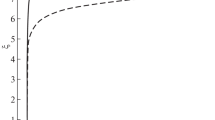Abstract
Based on the previously formulated mathematical model of a statistical system with scalar interaction of fermions, a cosmological model is studied, based on a one-component statistical system of doubly scalarly charged degenerate fermions interacting with an asymmetric scalar doublet of canonical and phantom scalar fields. A relationship of the presented model with previously studied models based on one-component and two-component fermion systems is investigated. The asymptotic and limiting properties of the cosmological model are investigated, it is shown that among all models there is a class of models with finite lifetime. The asymptotic behavior of models near the corresponding singularities is investigated, a qualitative analysis of the corresponding dynamical system is carried out, and numerical implementations of such models are constructed. Based on numerical integration, it is shown that in the present model there can be transitions from a stable asymptotically vacuum state with a zero canonical field and a constant phantom field, corresponding to the phase of cosmological compression, to a symmetric state corresponding to an expansion phase. The time interval of the transition between these phases is accompanied by oscillations of the canonical scalar field.















Similar content being viewed by others
Notes
In this article, we use the metric signature \((---+)\), and the Ricci tensor is determined by convolution of the first and third indices of the curvature tensor (see, for example, [16]).
See a discussion on this issue in [15].
Singlets with both canonical and phantom scalar fields were studied in the \(\mathfrak{M}_{00}\) and \(\mathfrak{M}_{0}\) models.
This state is not allowed in all cases of model parameters, see below.
See, e.g., [22].
We talked about that in Subsection 3.2.1.
Numerical integration gives the results \(\Phi(\mp\infty)=10^{-15}{-}10^{-14}\).
References
B. P. Abbott (LIGO Scientific Collaboration and Virgo Collaboration) et al., Phys. Rev. Lett. 116 (6), 102 (2016).
B.P. Abbott, Phys. Rev. Lett. 116 (24), 241103 (2016).
S. Gillessen, F. Eisenhauer, S. Trippe, T. Alexander, R. Genzel, F. Martins, and T. Ott, Astrophys. J. 692, 1075 (2009); arXiv: 0810.4674.
Sheperd Doeleman, Jonathan Weintroub, Alan E.E. Rogers, et al., Nature 455 78 (2008); arXiv: 0809.2442.
X. Fan, A. Barth, E. Banados, G. D. Rosa, R. Decarli, A.-C. Eilers, et al., Bulletin of the AAS 51 (3) (2019).
B. Trakhtenbrot, arXiv: 2002.00972.
Q. Zhu et al., arXiv: 2012.01458.
L. Arturo Ureña-Lopez and Andrew R. Liddle, Phys. Rev. D 66, 083005 (2002); astro-ph/0207493.
Pedro V. P. Cunha, Carlos A. R. Herdeiro, Eugen Radu, and Helgi F. Rúnarsson, Int. J. Mod. Phys. D 25 (9), 1641021 (2016).
Philippe Brax, Jose A. R. Cembranos, and Patrick Valageas, Phys. Rev. D 101, 023521 (2020); arXiv: 1909.02614.
Yu. G. Ignat’ev and A.A. Agathonov, Space, Times and Fundamental Interactions, issue 3(16), 48 (2016).
Yu. G. Ignat’ev, A. A. Agathonov, and D. Yu. Ignatyev, Grav. Cosmol. 24, 1 (2018); arXiv:1608.05020.
Yu. G. Ignat’ev, Grav. Cosmol. 27, 36 (2021); arXiv: 2103.13867.
Yu. G. Ignat’ev and D.Yu. Ignat’ev, Theor. Math. Phys. 209 (1), 144 (2021).
Yu. G. Ignat’ev, A. A. Agathonov, and D. Yu. Ignatyev, Grav. Cosmol. 27 (4), 338 (2021).
L. D. Landau and E. M. Lifshitz, The Classical Theory of Fields (Pergamon Press, Oxford, 1971).
Yu. G. Ignat’ev and I. A. Kokh, Theor. Math. Phys. 207, 514 (2021).
Yu. G. Ignat’ev, Grav. Cosmol. 26, 297 (2020).
Yu. G. Ignatyev, A. A. Agathonov, and D. Yu. Ignatyev, Grav. Cosmol. 20, 304 (2014).
Yu. Ignat’ev, A. Agathonov, M. Mikhailov, and D. Ignatyev, Astroph. Space Sci. 357, 61 (2015).
Yu. G. Ignat’ev, Grav. Cosmol. 26, 249 (2020).
N. N. Lebedev, Special Functions and Their Applications (Prentice-Hall, Englewood Cliffs, N.J., 1965).
Funding
This work was funded by the subsidy allocated to Kazan Federal University for the state assignment in the sphere of scientific activities.
Author information
Authors and Affiliations
Corresponding author
Ethics declarations
The authors declare that they have no conflicts of interest.
Additional information
aBasically, quasars, such as, for example, the supermassive BH SDS J140821. 67+025733.2 at the center of the quasar SDSS J140821, having a mass of \(1.96\times 10^{11}M_{\odot}\).
Rights and permissions
About this article
Cite this article
Ignat’ev, Y.G., Agathonov, A.A. & Ignatyev, D.Y. Cosmological Evolution of a Statistical System of Degenerate Scalarly Charged Fermions with an Asymmetric Scalar Doublet. II. One-Component System of Doubly Charged Fermions\({}^{a}\). Gravit. Cosmol. 28, 10–24 (2022). https://doi.org/10.1134/S0202289322010066
Received:
Revised:
Accepted:
Published:
Issue Date:
DOI: https://doi.org/10.1134/S0202289322010066



